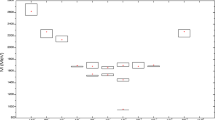Summary
We construct a trilocal baryon field yielding a linear Chew-Frautschi plot for its mass spectrum in conformity with the experiment. This field has a conserved current yielding a dipole form factor, which is also in agreement with the experiment. The field is coupled via a Yukawa-γ 5 coupling to a bilocal meson field, and a unitaryS-matrix is constructed in a perturbative manner. The expressions for the terms of higher order of thisS-matrix are formally very similar to those of a local field theory. Moreover, the Zweig-Iizuka rule automatically follows from the extended field theory we have formulated.
Riassunto
Si costruisce un campo barionico trilocale che dà un diagramma lineare di Chew-Frautschi per il suo spettro di massa in conformità con l’esperimento. Questo campo ha una corrente conservata che dà un fattore di forma dipolare che è pure in accordo con l’esperimento. Si accoppia il campo attraverso un accoppiamento Yukawa-γ 5 a un campo mesonico bilocale, e si costruisce una matrice unitariaS in maniera perturbativa. Le espressioni per i termini di ordine più alto di questa matriceS sono formalmente molto simili a quelli di una teoria di campo locale. Inoltre la regola di Zweig-Iizuka segue automaticamente dalla teoria estesa del campo che si è formulata.
Реэюме
Мы конструируем трилокальное барионное поле, приводяшее к линейной диаграмме Чу-Фраутчи для массового спектра в соответствии с зкспериментом. Это поле имеет сохраняюшийся ток, определяюший дипольный форм-фактор, который также согласуется с зкспериментом. Предложенное поле свяэано череэ свяэь Юкавы-γ5 с билокальным меэонным полем. Конструируется унитарнаяS-матрица в рамках пертурбационного подхода. Выражения членов более высокого порядка дляS-матрицы формально очень похожи на члены локальной теории поля. Кроме того, иэ теории протяженного поля автоматически следует правило Цвейга-Ииэуки.
Similar content being viewed by others
References
A. Z. Capri andC. C. Chiang:Nuovo Cimento,36 A, 331 (1976).
T. Takabayasi:Phys. Rev.,139, B 1381 (1965).
C. B. Chiu:Ann. Rev. Nucl. Sci.,22, 255 (1972).
R. G. Lipes:Phys. Rev. D,5, 2849 (1972).
H. Yukawa:Phys. Rev.,77, 219 (1950);80, 1047 (1950).
J. Rayski:Proc. Phys. Soc.,64, 957 (1951).
See,e.g.,D. R. Yennie:Phys. Rev.,80, 1053 (1950);O. Hara andH. Shimazu:Prog. Theor. Phys.,9, 137 (1953).
G. Zweig: CERN Report No. 8419/Th 412 (1964) (unpublished);I. Iizuka, K. Okada andO. Shito:Prog. Theor. Phys.,35, 1061 (1966).
P. G. O. Freund andY. Nambu:Phys. Rev. Lett.,34, 1645 (1975).
Author information
Authors and Affiliations
Additional information
Work supported in part by an Alexander von Humboldt-Dozentenstipendium and by the National Research Council of Canada.
Rights and permissions
About this article
Cite this article
Capri, A.Z., Chiang, C.C. Extended baryon fields and baryon-meson interaction. Nuov Cim A 38, 191–208 (1977). https://doi.org/10.1007/BF02724541
Received:
Published:
Issue Date:
DOI: https://doi.org/10.1007/BF02724541



